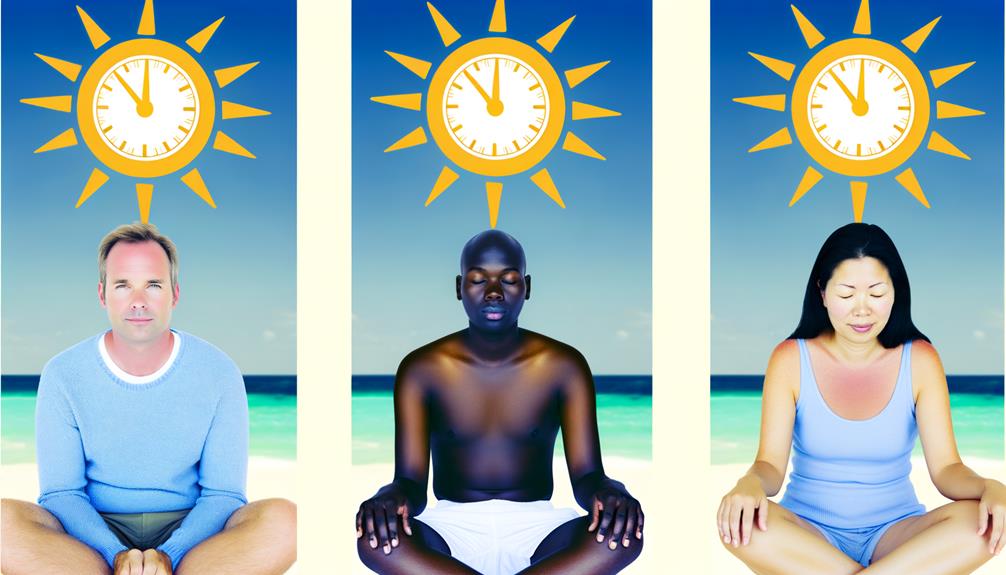
As summer approaches and the allure of a sun-kissed glow beckons, the question of how long it takes to achieve a tan becomes increasingly prevalent.
Understanding the intricacies of tanning is not merely a matter of aesthetics; it involves a delicate balance between sun exposure, skin type, and safety precautions.
So, just how long does it take to get a tan? The answer may not be as straightforward as one might think.
Let's unravel the mysteries of tanning, debunk common myths, and explore the nuances of achieving a bronzed complexion while safeguarding skin health.
Key Takeaways
- The duration of sun exposure needed for tanning varies based on skin tone, with fair to light skin requiring 10 to 30 minutes, light brown to dark brown skin needing 40 to 60 minutes, and dark brown or black skin may not see noticeable color change.
- Even in the shade, UV rays can still reach the skin, so it is important to apply sunscreen to protect against sun damage.
- It is possible to get a tan in one day, but it is recommended to tan slowly over a 2-week period to avoid sunburn. Spending 10 to 30 minutes outside each day with sunscreen is a good approach.
- Tanning in the pool does not necessarily make you tan faster than laying out in the sun. Both methods expose the skin to UV rays, so wearing sunscreen and practicing sun safety is important regardless of the method chosen.
Sun Exposure Time for Different Skin Tones

Determining the appropriate sun exposure time for different skin tones is essential for achieving a safe and effective tanning experience. The duration of sun tanning time varies depending on individual skin tones.
For fair to light skin, 10 to 30 minutes in the sun is adequate to achieve a tan, but extended exposure can lead to sunburn. Individuals with light brown to dark brown skin require 40 to 60 minutes in the sun to initiate tanning, with prolonged exposure risking sunburn. In the case of dark brown or black skin, tanning may not result in noticeable color change, but sunburn can occur after 40 to 60 minutes.
It's important to note that UV rays can still reach the skin in the shade, so tanning is possible even when not directly under the sun. Sunscreen application is crucial, even when in the shade or on cloudy days.
To achieve a tan without risking sunburn, it is recommended to spend 10 to 30 minutes outside daily and gradually increase sun exposure over a 2-week period, always wearing sunscreen. It's important to understand that tanning, in any form, can lead to skin damage, premature aging, and an increased risk of skin cancer. Therefore, protecting the skin with sunscreen and other sun safety practices is paramount.
Tanning in the Shade
When considering tanning in the shade, it's important to understand that UV rays can still reach your skin, allowing for the possibility of tanning even when not directly exposed to the sun. While it's true that sitting in the shade reduces your direct exposure to the sun, it doesn't eliminate the UV rays completely. This means that even in the shade, tanning is still possible.
It's important to note that the amount of time needed to tan in the shade can vary based on factors such as skin type and the intensity of UV rays. Applying sunscreen when in the shade is essential to protect your skin from potential damage caused by UV rays.
Even on cloudy days, UV rays can penetrate through the clouds, so sunscreen is necessary regardless of the weather. Remember that tanning, whether in the sun or shade, carries potential risks, so it's crucial to practice sun safety and protect your skin.
Time Required for a Tan

The time required for achieving a tan varies depending on individual skin type and sun exposure, with a gradual approach recommended to minimize the risk of sunburn. It's important to understand your skin type and how it responds to sun exposure. Here's a breakdown of the duration of sun exposure needed for tanning based on different skin types:
| Skin Type | Time Required for Tanning |
|---|---|
| Fair to light skin | 10 to 30 minutes in the sun, longer may cause sunburn |
| Light brown to dark brown skin | 40 to 60 minutes in the sun needed to start tanning |
| Dark brown or black skin | Tanning may not result in noticeable color change, but sunburn can still occur after 40 to 60 minutes |
The key is to tan gradually over a 2-week period, spending 10 to 30 minutes outside every day and wearing sunscreen. It is crucial to be mindful of sun safety practices and to protect your skin against potential damage. Always consider using a high SPF sunscreen, wearing protective clothing, and seeking shade during peak sun hours to minimize the risks associated with tanning.
Tanning in the Pool Vs Laying Out
Understanding the time required for tanning based on individual skin types and sun exposure, it is important to consider the effectiveness of tanning in the pool versus laying out.
- Tanning in the Pool:
- Swimming in the pool can provide a cooling effect, making it more comfortable to spend time in the sun.
- However, the water can reflect UV rays, potentially intensifying sun exposure and increasing the risk of sunburn.
- Additionally, the effectiveness of tanning in the pool depends on the depth of the water and the body's position in relation to the sun.
- Laying Out:
- When laying out, individuals have more control over their sun exposure and can easily adjust their position to ensure even tanning.
- It allows for the application of sunscreen to protect the skin while still achieving a tan.
- However, prolonged exposure to direct sunlight while laying out can also lead to sunburn if not managed properly.
- General Considerations:
- Both methods expose the skin to UV rays, but it is essential to prioritize sun safety by using sunscreen and limiting exposure during peak sun hours.
Safety Considerations for Tanning

Ensuring the safety of tanning practices requires a comprehensive understanding of the potential risks and protective measures associated with sun exposure. When considering how long tanning should take, it's essential to prioritize safety.
The amount of time it takes to tan varies based on skin type and UV index. Fair to light skin may need 10 to 30 minutes in the sun for a tan, whereas light brown to dark brown skin may need 40 to 60 minutes. Dark brown or black skin may not show noticeable color change but can still experience sunburn after 40 to 60 minutes.
It's crucial to apply sunscreen even in the shade, as UV rays can still penetrate through. Cloudy days also expose the skin to the sun, so sunscreen is necessary.
Understanding the duration of sun exposure for tanning and the best times to tan in the sun can help minimize the risk of sunburn, premature aging, and skin cancer. Practicing sun safety, wearing protective clothing, and using high SPF sunscreen are essential for protecting the skin during tanning.
It's important to note that indoor tanning is not safer than outdoor tanning and still carries the risk of skin damage. Ultimately, prioritizing safety and being mindful of the potential risks associated with tanning is crucial for overall skin health.
Frequently Asked Questions
What Are Some Tips for Maintaining a Tan Once You Have Achieved the Desired Color?
To maintain a tan, moisturize your skin daily to extend its longevity. Avoid prolonged sun exposure, as it can cause skin damage. Use self-tanning products or gradual tanning lotions to touch up your tan as needed.
Can Certain Medications or Skincare Products Affect the Tanning Process?
Certain medications and skincare products can affect the tanning process. Some medications make the skin more sensitive to sunlight, leading to faster burns. Exfoliating skincare products can also affect the skin's ability to tan evenly. Always consult with a healthcare professional.
Are There Any Specific Foods or Supplements That Can Help Enhance the Tanning Process?
Enhancing the tanning process through specific foods or supplements is a popular inquiry. While certain nutrients and antioxidants may support skin health, there's limited evidence directly linking them to hastened tanning. Prioritize sun safety and consult a healthcare professional.
How Does the Use of Tanning Oils or Lotions Affect the Tanning Process?
Tanning oils or lotions can enhance the tanning process by accelerating melanin production and moisturizing the skin. They may also offer added protection against UV rays. However, it's crucial to choose products with SPF and use them as directed.
Can Tanning Help Improve Certain Skin Conditions, Such as Eczema or Psoriasis?
Tanning may provide temporary relief for skin conditions like eczema or psoriasis due to UV exposure. However, dermatologists advise against it due to potential long-term skin damage, including increased risk of skin cancer. Sunscreen and protective clothing are recommended.





